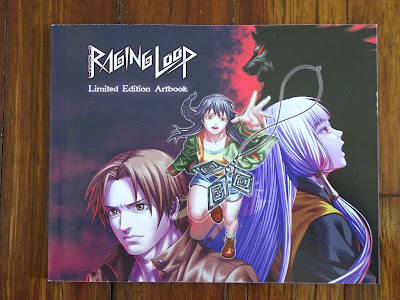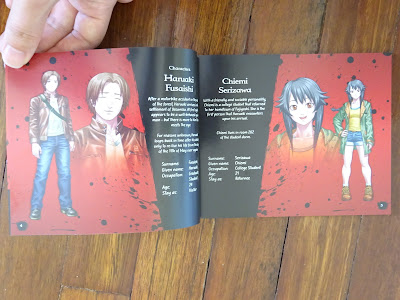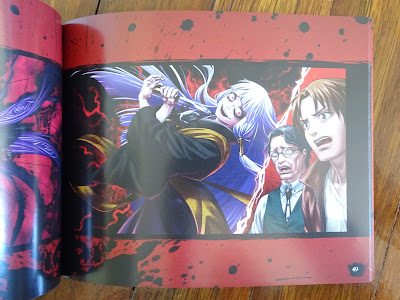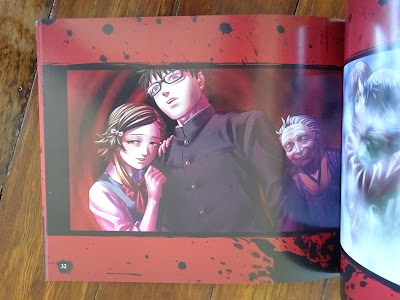Raging Loop is a visual novel that has a slow beginning as it sets up the premise. Haruaki was traveling on his bike when he got lost in the mountains. Stumbling upon a small village, he gets wrapped up within its local legends and rituals. He initially meets up with Chiemi, who had helped him and given him a place to stay for the night. However, his coming is a bad omen as the small village doesn’t like outsiders. Coincidentally, or perhaps not so much, the supernatural things that happen on the very next day and he is forced to stay in the village.
Without spoiling too much, there is a certain ritual that the village has where all the villagers must participate in a type of game. It doesn’t happen often, thus many of the villagers have never been in one before. It’s based on the real-life party game Mafia, alternatively known as Werewolf, a social deduction game. Basically, it is a game where there are traitors among the group and the others must find out who they are and oust them. What makes this a deadly game is that there are very strict rules to follow, and this is a game of life or death. With each passing day, people will die and if all the non-traitors are dead, then it is game over and they win. To help balance the game for a bit, there are some other elements that helps with their logical reasoning.
The game warns you about this beforehand, but it can still be a bit uncomfortable. The game does not shy away from describing gory scenes. Characters die in inhumane ways and the descriptions of their corpses don’t leave too much to the imagination, or perhaps leaves a lot more. Either way, it strikes a balance between over-stylizing and giving too much detail. Thus, it makes each death more surprising and more impactful. This is important because once the game starts, the pacing considerably amps up.
Haruaki is an important character as he is in a unique position int eh game. He also provides most of the commentary but as the player, he is not the only viewpoint you get to see. For story purposes, the player gets to see a little bit more of what happens with other characters even when Haruaki is not present. The game has multiple endings and there are occasionally choices that dictate what ending you’ll get. Most of the endings are bad endings. There is a handy chart in-game so that you can easily jump back to the important choices, and it’s even explained in the story as an ability of Haruaki’s. He mysteriously can vaguely recall what happened in those bad endings.
The game is quite linear, despite the choices. This is because a lot of the cohices are locked the first time you play through, and they can only be unlocked once you’ve reached the various good and bad endings. This is where the “loop” from the title comes in since to the character, it is like he is going through various loops. He’s returning after death again and again but this time, he tries and does something different so that he can break the curse once and for all. The looping aspect, while not the most original, is well done here. Having Haruaki analyze and use logic, going through their thought processes, was very engaging and interesting. There are surprising developments and just finding out which characters were the “wolves” is unexpected.
The game can get very bleak and full of despair. Playing through the story for the first time, you are forced again and again to hit bad endings and even the other “true” endings that you get are depressing. You push through in the hopes of reaching that one golden ending and to fully uncover all the mysteries that the story has presented to you. The story is long though, especially with all the alternate endings you must go through to get to the true ending. You must go through the story multiple times, but this isn’t a bad thing because each time feels completely different than the first. The character interactions and the story developments are unique, yet they are all linked to each other in some way. The further you go; the more tantalizing pieces of information are revealed and there are so many mysteries that are piled up.
While you may be eager for the revelations and all the questions to finally be answered, it is not quite that easy. You must find a few other sections scattered in the story to unlock the true ending. Unfortunately, the true ending tries to wrap everything together, but it felt like all the creative juices were used in the parts of the story before the game and all the supernatural happenings. The explanation was a stretch, and the motivations of several characters were lacking. There were also questions that felt like they didn’t get answered at all. The game takes 20 hours or so to complete, depending on how fast you read.
The game’s aesthetics is unique, and the music is foreboding. Although if you have played visual novels before, you can tell that the game’s budget may not have been that high given the lackluster backgrounds and regular reuse of various assets. It doesn’t detract from the story though and it still grips you. There may be similarities between it and the Danganronpa series in terms of its premise, but it is its own unique thing and doesn’t feel like it ripped off from other visual novels. The mystery moves at a brisk pace and constantly builds up suspicions around characters. The story will constantly give you the chills and has a sense of creepiness to it, yet it is not a horror game.
Surprisingly, there is a lot of content after you get the true ending. First, there are five additional short stories that take place after the end of the story. Although to be honest, these felt thematically different to the story and thus tackled on. The same goes for the secret gag endings, although at least those were purposely non-serious. It’s just that the ending felt so final so anything that came afterwards just does not have the same importance or relevance.
However, the biggest piece of post-game content is “Revelation” mode. In this mode, throughout the story, it will inject new content that reveals the thoughts of the other characters, rather than just Haruaki. It sheds light on the character motivations and encourages the player to replay the whole story. This feels like the “complete” story as it fully reveals every single thing that happened, including events that Haruaki was not privy to. Events make a lot more sense and seeing what the thought process of the side characters is like pieces of the puzzle finally clicking into player. It’s just a shame that due to its spoileriffic nature that it couldn’t have been incorporated into the first playthrough for a new player. It doesn’t save the ending, but it goes a long way to rationalizing most of the game.
Overall, Raging Loop is a surprising hit. It’s surprising because of how good it manages to capture the atmosphere and tension of the situation. It’s surprising because it isn’t more well known given that its execution is up there with some of the best visual novels. It kept the mystique and intrigue going the whole time. All the characters grow on you, especially as you continue with the game and naturally seeing each of their personalities, strengths, and weaknesses. Despite being a game where you are supposed to find bad endings, go back, and repeat events, none of the paths feel repetitive at all as they are all unique developments. The only weakness ist he ending as well as some of the bonus content.
-----------------------------------------------
 |
| Purchase from Amazon using this link. |
(As an Amazon Associate I earn from qualifying purchases)
-----------------------------------------------
The physical copy of the game packed a few extra goodies. It came in a cardboard sleeve containing an artbook. Here are some samples below.






















































